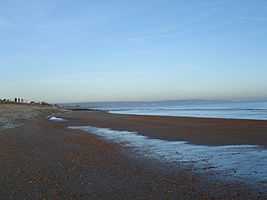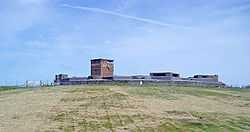Dymchurch
| Dymchurch | |
 Dymchurch Beach |
|
 Dymchurch | |
| Population | 3,605 (parish, 2001 Census) |
|---|---|
| District | Shepway |
| Shire county | Kent |
| Region | South East |
| Country | England |
| Sovereign state | United Kingdom |
| Police | Kent |
| Fire | Kent |
| Ambulance | South East Coast |
| EU Parliament | South East England |
| UK Parliament | Folkestone and Hythe |
Dymchurch is a village and civil parish in the Shepway District of Kent, England. The village is located on the coast five miles (8 km) south-west of Hythe, and on the Romney Marsh.
History
The history of Dymchurch began with the gradual build-up of the Romney Marsh.[1]
New Hall was rebuilt in 1575 after an earlier wooden structure was destroyed in a fire. It was used as a court room for the Romney Marsh area. The head magistrate was known as Leveller of the Marsh Scotts. It was there that the so-called Scot tax[2] was introduced, levied on residents to fund maintenance of the sea wall. Those directly outside the boundaries and thus not eligible for the tax were said to have got away "Scott Free". Residents with land were required to grow thorn bushes for building of the wall, as thorn twigs were believed impervious to sea water. Failure resulted in an ear being cut off.
During the 17th and 18th centuries, smuggling was rife all along the south east coast of England. Due to its remote location, Romney Marsh and the surrounding areas were amongst the busiest locations for illicit trade. Inspiration from this gave rise to Dymchurch being the setting of the Doctor Syn novels, based on smuggling, by Russell Thorndike. Every two years a celebration of the novels is held, usually on August Bank Holiday.
Dymchurch Martello towers
Several Martello towers were built in the nineteenth century as part of an Empire-wide coastal defence programme: most have since fallen into the sea or become dilapidated. Tower 23 was restored externally in the early 1970s and is currently a private residence. Tower 24 has undergone renovation and using Tower 23 used as a guide: in 1969 it became the first Martello tower to be opened to the public and remains as a museum of Martello Towers, owned by English Heritage. Tower 25 is possibly the only empty tower that is regularly maintained.[3]
Dymchurch Redoubt
Two redoubt forts were constructed into the south coast Martello chain to act as supply depots for the local Martellos, and were originally described as "eleven-gun towers". A four-gun tower was originally proposed at Dymchurch, but this idea was revised at the Rochester conference of 1804. Dymchurch Redoubt was built between 1806 and 1809 to the same specifications as its Eastbourne counterpart, although Dymchurch does not have any caponiers.
In 1908, Walter Jerrold described the village as "a quiet scattered village and a delightful place far from the madding crowd". It is typical of this part of the coast, having originally been a very small village which became a much larger settlement during the 1930s. Many of homes from this era were converted railway carriages: very few of these remain, although a few similar ones still exist in nearby Dungeness. Dymchurch is now a popular seaside resort complete with holiday camp, caravan parks, light railway station and amusement park. Today the village is relatively large and mainly dedicated to seasonal tourism.
World War Two
On 24 August 1940, Dymchurch was bombed and the first local fatalities by enemy action were sustained, when Alfred and Ada Austin were killed. Their house, Sea Breeze, was rebuilt .the Observer Corps used martello tower 25 as a vantage post and it was there the first V-1 flying bomb to fly over England was spotted.
In 1942, the primary school suffered a direct hit from a bomb dropped from a plane. The teacher and pupils had managed to escape to the bomb shelter and there were no reported casualties. In February 1944 a USAF Flying Fortress developed engine trouble while returning from a bombing raid and crashed into the police station, damaging several neighbouring houses in lyndhurst road. A soldier was killed and three people injured.
In May 1944, 22 soldiers were killed by the explosion of anti-tank grenades at Dymchurch. The cause of the explosion was uncertain; at the inquest it was suggested that it may have been the heat of the sun, or a match-head falling into a box of detonators.
Dymchurch underwent significant re-fortification during the Second World War, with bunkers and pillboxes adorning its parapets. The gun platforms were encased in concrete for machine guns to be mounted, artillery emplacements constructed and an observation post erected. On the western extreme of the Hythe Ranges, during the 1970s the Redoubt was being used by the British Army for training soldiers for urban combat. The ranges remain in the possession of the Ministry of Defence.
Famous residents
In January 1867, the Courier de Dieppe was spotted floundering in a gale off Dymchurch, with the crew clinging to the rigging and one by one dropping off into the sea. After repeated attempts, a line was thrown to the boat, but by this time there was only one of its crew left. The Reverend Charles Cobb, rector of the parish, volunteered to swim to the boat in an attempt to save the last man. Encouraged on by his wife and the gathered crowd, he dived into the troubled waters and swam the 50 or more feet to the vessel. He was then joined by a local coastguard, John Batist. Together they reached the trapped man, and managed to carry and drag him back to shore where they received much applause for their heroism. The rescued man was the only survivor of a crew of four from the ship. Cobb was awarded the Albert Medal of the First Class and Batist was awarded the Albert Medal of the Second Class. The street nearest to where this heroic action occurred was later named "Charles Cobb Close" in his memory.
Transport
The main road into the village is the A259.
The Romney, Hythe and Dymchurch Railway was originally opened in the 1920s, but closed during World War Two. Dymchurch railway station was reopened after the war by Laurel and Hardy.
Bus routes
Three main bus routes serve the area: the 101 and 102 Dover to Lydd-on-Sea and the 105 Folkestone to Lydd-on-Sea: both of these are circular routes operated by Stagecoach.
Sea defences
Dymchurch has had a sea wall since Roman times, with the original development being constructed to protect the harbour at Port Lympne. The original structure is believed to have run for some 4 miles and to have stood 20 ft high. This wall, together with the Rhee Wall erected between New Romney and Appledore, ensured that the rich alluvial land deposited by the river Limen (Rother) which had initially been used as salt pans, slowly became rich and fertile farmland.
In July 2011, a new sea wall, built at a cost of £60 million, was officially opened by the Rt. Hon. Lord Smith of Finsbury, Chairman of the Environment Agency. He announced that "the scheme was implemented by the Environment Agency as part of the wider Folkestone to Cliff End Sea Defence Strategy, the sea defence project which will protect 2,500 properties from flooding. The high cost of flooding underlines the importance of investment in reducing flood risk." He also added "The agency said storms and raised sea levels are due with climate change."
The wall between the High Knocke Estate and Dymchurch won a British Construction Industry Award in 2011.[4]
The new wall allows pedestrians to walk the sea shore for the entire length of the village, approximately four miles, from Hythe Military Rifle Ranges in the East to St Mary's Bay Boundary in the West. Cyclists have the same freedom but must dismount for about 500m around the area of the public amenities. Dymchurch Wall
Population
The population has grown due to large development since 2001 and is estimated at 5820 (Est 2004). The village has one primary school. The proportion of pupils known to be eligible for free school meals is broadly average. Most pupils are of White British heritage. The proportion of pupils from minority ethnic heritages is much lower than average, as is the percentage who speak English as an additional language. The proportion of pupils with special educational needs and/or disabilities is broadly average, although in some year groups it is much higher. The school caters for children in the Early Years Foundation Stage in a Reception class. The school has about 180 pupils. (Source: OFSTED Report 2011)
Buildings of note
The Norman church in Dymchurch, dedicated to St Peter & St Paul,[5] is classic Norman, built in the about 1150. The first recorded rector was Richard de Bello in 1260. The church remained virtually unchanged for nearly 700 years. In 1821 the population of Dymchurch increased to the point where extensions and modifications were required, and the north aisle was extended and the nave re-roofed giving the church its present lop-sided appearance.
Local media
Newspapers
Dymchurch has two paid-for newspapers, the Romney Marsh Herald (published by Kent Regional News and Media) and the Kentish Express (published by the KM Group). Free newspapers for the area include the Folkestone and Hythe Extra, part of the KM Group, and Your Shepway, part of KOS Media.
Radio
The local radio station for Dymchurch is KMFM Shepway and White Cliffs Country. The area is also served by the county-wide stations Heart, Gold and BBC Radio Kent.
References
- ↑ "Dymchurch:The Romans and the Sea Wall". Village Net: Dymchurch. Retrieved 10 June 2012.
- ↑ The name given, historically, to any such tax raised to share burdens in a community: Concise Oxford Dictionary
- ↑ "Martello tower number 24". martello-towers.co.uk. Retrieved June 10, 2012.
- ↑ "Winners 2011". www.bciawards.org.uk. 2011. Retrieved 14 December 2013.
- ↑ "St. Peter and St. Paul's church website". Retrieved 10 June 2012.
-

A view along the High Street
-

Donkey rides on the beach
-

The beach looking towards Hythe
-

A view of the High Street looking from Eastbridge Road
External links
![]() Media related to Dymchurch at Wikimedia Commons
Media related to Dymchurch at Wikimedia Commons

